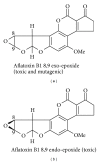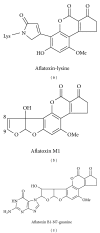The molecular epidemiology of chronic aflatoxin driven impaired child growth
- PMID: 24455429
- PMCID: PMC3881689
- DOI: 10.1155/2013/152879
The molecular epidemiology of chronic aflatoxin driven impaired child growth
Abstract
Aflatoxins are toxic secondary fungal metabolites that contaminate dietary staples in tropical regions; chronic high levels of exposure are common for many of the poorest populations. Observations in animals indicate that growth and/or food utilization are adversely affected by aflatoxins. This review highlights the development of validated exposure biomarkers and their use here to assess the role of aflatoxins in early life growth retardation. Aflatoxin exposure occurs in utero and continues in early infancy as weaning foods are introduced. Using aflatoxin-albumin exposure biomarkers, five major studies clearly demonstrate strong dose response relationships between exposure in utero and/or early infancy and growth retardation, identified by reduced birth weight and/or low HAZ and WAZ scores. The epidemiological studies include cross-sectional and longitudinal surveys, though aflatoxin reduction intervention studies are now required to further support these data and guide sustainable options to reduce the burden of exposure. The use of aflatoxin exposure biomarkers was essential in understanding the observational data reviewed and will likely be a critical monitor of the effectiveness of interventions to restrict aflatoxin exposure. Given that an estimated 4.5 billion individuals live in regions at risk of dietary contamination the public health concern cannot be over stated.
Figures





Similar articles
-
Agricultural and nutritional education interventions for reducing aflatoxin exposure to improve infant and child growth in low- and middle-income countries.Cochrane Database Syst Rev. 2020 Apr 9;4(4):CD013376. doi: 10.1002/14651858.CD013376.pub2. Cochrane Database Syst Rev. 2020. PMID: 32270495 Free PMC article.
-
Determinants of aflatoxin exposure in young children from Benin and Togo, West Africa: the critical role of weaning.Int J Epidemiol. 2003 Aug;32(4):556-62. doi: 10.1093/ije/dyg109. Int J Epidemiol. 2003. PMID: 12913029
-
Nutrition and growth outcomes are affected by aflatoxin exposures in Kenyan children.Food Addit Contam Part A Chem Anal Control Expo Risk Assess. 2020 Dec;37(12):2123-2134. doi: 10.1080/19440049.2020.1825825. Epub 2020 Oct 7. Food Addit Contam Part A Chem Anal Control Expo Risk Assess. 2020. PMID: 33026957
-
The Minderoo-Monaco Commission on Plastics and Human Health.Ann Glob Health. 2023 Mar 21;89(1):23. doi: 10.5334/aogh.4056. eCollection 2023. Ann Glob Health. 2023. PMID: 36969097 Free PMC article. Review.
-
Dietary exposure to aflatoxin from maize and groundnut in young children from Benin and Togo, West Africa.Int J Food Microbiol. 2005 Oct 15;104(2):215-24. doi: 10.1016/j.ijfoodmicro.2005.03.004. Int J Food Microbiol. 2005. PMID: 15979184
Cited by
-
Plasma Proteome Biomarkers of Inflammation in School Aged Children in Nepal.PLoS One. 2015 Dec 4;10(12):e0144279. doi: 10.1371/journal.pone.0144279. eCollection 2015. PLoS One. 2015. PMID: 26636573 Free PMC article. Clinical Trial.
-
Complementary feeding in Kongwa, Tanzania: Findings to inform a mycotoxin mitigation trial.Matern Child Nutr. 2021 Oct;17(4):e13188. doi: 10.1111/mcn.13188. Epub 2021 May 4. Matern Child Nutr. 2021. PMID: 33945210 Free PMC article.
-
Determination of aflatoxin M1 and deoxynivalenol biomarkers in infants and children urines from Bangladesh.Arch Toxicol. 2020 Nov;94(11):3775-3786. doi: 10.1007/s00204-020-02857-5. Epub 2020 Sep 3. Arch Toxicol. 2020. PMID: 32880717 Free PMC article.
-
Association Between Aflatoxin Exposure and Haemoglobin, Zinc, and Vitamin A, C, and E Levels/Status: A Systematic Review.Nutrients. 2025 Feb 28;17(5):855. doi: 10.3390/nu17050855. Nutrients. 2025. PMID: 40077727 Free PMC article.
-
Aflatoxin M1 in human breast milk in southeastern Turkey.Mycotoxin Res. 2017 May;33(2):103-107. doi: 10.1007/s12550-016-0268-4. Epub 2016 Dec 28. Mycotoxin Res. 2017. PMID: 28032266
References
-
- CAST. Mycotoxins: Risks in Plant, Animal, and Human Systems. Ames, Iowa, USA: Council for Agricultural Science and Technology; 2003. Potential economic costs of mycotoxins in the United States; pp. 136–142. (Task Force Report No. 139).
-
- Armbrecht B, Wiseman H, Shalkop W, Geleta J. Swine aflatoxicosis. I. An assessment of growth efficiency and other responses in growing pigs fed aflatoxin. Environmental Physiology & Biochemistry. 1971;1:198–208.
-
- Bryden WL, Cumming RB, Balnave D. The influence of vitamin A status on the response of chickens to aflatoxin B1 and changes in liver lipid metabolism associated with aflatoxicosis. British Journal of Nutrition. 1979;41(3):529–540. - PubMed
-
- Butler W, Wigglesworth J. The effects of aflatoxin B1 on the pregnant rat. British Journal of Experimental Pathology. 1966;47:242–247.
-
- Dersjant-Li Y, Verstegen MWA, Gerrits WJJ. The impact of low concentrations of aflatoxin, deoxynivalenol or fumonisin in diets on growing pigs and poultry. Nutrition Research Reviews. 2003;16(2):223–239. - PubMed
Publication types
LinkOut - more resources
Full Text Sources
Other Literature Sources

